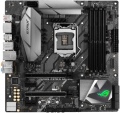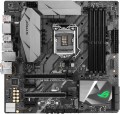Wi-Fi version (standard) supported by the motherboard Wi-Fi module. The main function of such modules, regardless of version, is Internet access via wireless routers; however, Wi-Fi can also be used to communicate directly with other devices—for example, to transfer content from a digital camera or control it remotely.
Nowadays you can find support for different Wi-Fi standards (up to
Wi-Fi 6,
Wi-Fi 6E,
Wi-Fi 7). The maximum connection speed primarily depends on this nuance. At the same time, different versions also differ in the ranges used; and they are compatible with each other if they coincide in the ranges used. However, wireless modules of modern motherboards often support not only the Wi-Fi standard specified in the specifications, but also earlier ones; It doesn’t hurt to clarify this point separately, but in most cases there are no compatibility problems. However, to use all the features of a particular version, it must be supported by both devices - both the motherboard and the external device.
The list of major versions looks like this:
- Wi-Fi 3 (802.11g). The oldest standard that is relevant today, in its pure form, is found only in frankly outdated boards. Operates at speeds up to 54 Mbps in the 2.4 GHz band.
— Wi-fi 4 (802.11n). Quite a popular standard, which has only recently begun to give w
...ay to more advanced options. Supports both the 2.4 GHz band and the more advanced 5 GHz band, and the maximum data transfer rate is 150 Mbps per channel (up to 600 Mbps with 4 antennas).
— Wi-Fi 5 (802.11ac). Works only on 5 GHz. Initially, the maximum theoretical data transfer rate was 1300 Mbit/s, but since 2016 the 802.11ac Wave 2 standard has been used, where this figure has been increased to 2.34 Gbit/s.
- Wi-Fi 6 (802.11ax). It initially operates on two bands - 2.4 GHz and 5 GHz - but the specification of this standard provides for the possibility of using any operating band between 1 GHz and 7 GHz (as such bands become available). The nominal data transfer speed has increased by only a third compared to Wi-Fi 5, but a number of improvements that increase communication efficiency allow for a significant increase in actual speed - in theory, up to 10 Gbps and even higher.
- Wi-Fi 6E (802.11ax). An improved branch of the Wi-Fi 6 standard with data transfer speeds up to 10 Gbps. The Wi-Fi 6E standard is technically called 802.11ax. But unlike basic Wi-Fi 6, which is named similarly, it provides for operation in the unused 6 GHz band. In total, the standard uses 14 different frequency bands, offering high throughput with many active connections.
— Wi-Fi 7 (802.11be). The technology, like the previous Wi-Fi 6E, is capable of operating in three frequency ranges: 2.4 GHz, 5 GHz and 6 GHz. At the same time, the maximum bandwidth in Wi-Fi 7 was increased from 160 MHz to 320 MHz - the wider the channel, the more data it can transmit. The IEEE 802.11be standard uses 4096-QAM modulation, which also allows more symbols to be accommodated in a data transmission unit. From Wi-Fi 7 you can squeeze out a maximum theoretical information exchange rate of up to 46 Gbps. In the context of using wireless connections for streaming and video games, the implemented MLO (Multi-Link Operation) development seems very interesting. With its help, you can aggregate several channels in different ranges, which significantly reduces delays in data transmission and ensures low and stable ping. And Multi-RU (Multiple Resource Unit) technology is designed to minimize communication delays when there are many connected client devices. 
